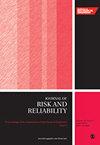A multi-step approach for reliability-based robust design optimization of truss structures
IF 1.8
4区 工程技术
Q3 ENGINEERING, INDUSTRIAL
Proceedings of the Institution of Mechanical Engineers Part O-Journal of Risk and Reliability
Pub Date : 2023-02-06
DOI:10.1177/1748006x231152633
引用次数: 1
Abstract
There are two general methods of robust design optimization (RDO) and reliability-based robust design optimization (RBRDO) for the optimal design of structures with non-deterministic variables. In the problem-solving process of both RDO and RBRDO, assessing the probabilistic constraints of the problem and the standard deviation of the structural responses is time-consuming and costly. In this study, by presenting a multi-step approach, for a probable optimal solution, the deterministic constraints are first investigated. Then the limit state functions related to probabilistic constraints are computed based on the mean value of random variables (in the RBRDO problem) and in the step of uncertainties effects simulation on the response of the structure, probabilistic constraints are evaluated (in the RBRDO problem). Designs that not meeting the deterministic constraints or in the unsafe area for the mean values of the random variables are not included in calculating the first and second terms of the objective function and reliability assessment. This leads to reduce the volume of calculations. The Monte Carlo simulation method is used to assess the probabilistic constraints, and the EVPS metaheuristic algorithm is used for the optimization process. Three benchmark trusses of 10, 25, and 72 bars were studied to assess the efficiency of the proposed approach. The first objective function in these problems was the mean weight of trusses and the second objective function was the standard deviation of the displacement of a specific node in a certain direction.基于可靠性的桁架结构稳健设计优化多步骤方法
针对不确定变量结构的优化设计,一般有稳健设计优化和基于可靠性的稳健设计优化两种方法。在RDO和RBRDO的问题解决过程中,评估问题的概率约束和结构响应的标准差是耗时和昂贵的。在这项研究中,通过提出一个多步骤的方法,对于一个可能的最优解,确定性约束首先进行了研究。然后根据随机变量的均值计算与概率约束相关的极限状态函数(在RBRDO问题中),在不确定性对结构响应的影响模拟步骤中,评估概率约束(在RBRDO问题中)。不满足确定性约束或随机变量均值处于不安全区域的设计不包括在目标函数第一项和第二项的计算和可靠性评估中。这样可以减少计算量。采用蒙特卡罗模拟方法评估概率约束,采用EVPS元启发式算法进行优化。三个基准桁架10,25和72杆进行了研究,以评估所提出的方法的效率。这些问题的第一个目标函数是桁架的平均权重,第二个目标函数是特定节点在某一方向上的位移的标准差。
本文章由计算机程序翻译,如有差异,请以英文原文为准。
求助全文
约1分钟内获得全文
求助全文
来源期刊

Proceedings of the Institution of Mechanical Engineers Part O-Journal of Risk and Reliability
ENGINEERING, MULTIDISCIPLINARY-ENGINEERING, INDUSTRIAL
CiteScore
4.50
自引率
19.00%
发文量
81
审稿时长
6-12 weeks
期刊介绍:
The Journal of Risk and Reliability is for researchers and practitioners who are involved in the field of risk analysis and reliability engineering. The remit of the Journal covers concepts, theories, principles, approaches, methods and models for the proper understanding, assessment, characterisation and management of the risk and reliability of engineering systems. The journal welcomes papers which are based on mathematical and probabilistic analysis, simulation and/or optimisation, as well as works highlighting conceptual and managerial issues. Papers that provide perspectives on current practices and methods, and how to improve these, are also welcome
 求助内容:
求助内容: 应助结果提醒方式:
应助结果提醒方式:


